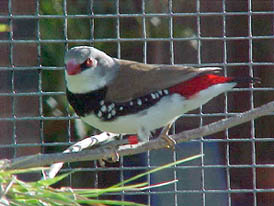The publication of The Finch Society of Australia.
Also published in the October issue of The Western Australian Avicultural Magazine.
The publication of The Avicultural Society of Western Australia.
Introduction. The Diamond Firetail is a very attractive member of the firetail family of which there are three other members namely the Painted Finch, Beautiful Firetail & Red Eared Firetail, the latter two species are virtually unknown to aviculture, kept only by a handful of aviculturists and zoos.
Description.
See photos for visual description.
Sexing.
Diamond keepers use a variety of methods to sex diamond firetails, I have come to rely on ringing all birds differently and putting up a high springy perch in a position I can easily view. The male diamonds will find a long piece of grass, hold it from the end and do a bouncing dance whilst extending his body and holding his beak into his chest, ruffling all the grey feathers on his neck. All the while holding the perch with both feet. Each time I see a bird dance properly I record it's ring details, eventually all the males get recorded dancing several times, it can be fairly safely presumed the rest are hens. Often males can be picked using this method before full adult coloring is obtained.
Another method I have recently noticed and found very useful is to take a picture of three or more fully colored diamonds together showing their leg rings. When scanned and zoomed up on a computer you can easily pick the sexes by their red rump feathers, the hen is light red and the cock is a darker crimson, the more the photo is zoomed the easier the difference can be picked. The same method can also be used with the orange mutation, although orange diamonds can be sexed with the naked eye quite easily. When using this method it is far more certain to view birds in the same frame, so the light conditions are the same. This is easier and faster still with a digital camera. Housing.
Diamond firetails are kept the world over in a variety of ways, In Australia they are often bred in large colonies of three to ten or more pairs in large outdoor aviaries or single pairs with a mixed finch collection. I have experimented with both colonies and single pairs and found single pairs do better than colonies. Although they will breed satisfactorily with both methods, in colonies I find that often when two or more pairs hatch young within days of each other, in close proximity to each other, the small area around the nest entrance they were defending, widens. Bickering occurs resulting in only one nest surviving. The dead young's parents lose interest in fighting turning their attentions to nest building once again. Better results can be gained by breeding single pairs in adjacent parrot type 4m x 1m flights.
All types of housing should have access to shelter from sun, wind and rain. The birds will decide when they need to escape the elements. I have never known a Diamond firetail to roost on a perch in the open flight, my aviaries are divided into approximately � weather proof roosting hut and � wire roofed flight which is covered with galvanised roofing one sheet along the outer wall. Prickly paper bark branches are placed under all sheltered sections for nesting and roosting, the diamonds in my aviaries use the outdoor brush nesting sites exclusively for nest building, I have never had them nest in the roosting section of the aviary preferring always to roost outdoors in a nest built in the branches. Occasionally they will choose a commercial wicker basket placed in the branches. Of the species of finch I keep (six Australian and two foreign) the Diamonds are always first to roost, disappearing at the first sign of the onset of night, Strangely they are also last to appear in the mornings.
